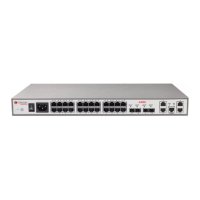A10E/A28E/A28F Configuration Guide
Restore mode: port-up
Active Port(State) Backup Port(State) Vlanlist
-----------------------------------------------------------------
1 (Down) 2 (Up) 100-150
2 (Up) 1 (Down) 151-200
When Port 1 resumes and keeps Up for 15s (restore-delay), it forwards traffic of VLANs 100–
150 while Port 2 forwards traffic of VLANs 151–200.
7.3 Failover
7.3.1 Introduction
Failover is used to provide port linkage scheme for specific application and it can extend
range of link backup. By monitoring uplinks and synchronizing downlinks, add uplink and
downlink interfaces to a failover group. Therefore, faults of uplink devices can be informed to
the downlink devices to trigger switching. Failover can be used to prevent traffic loss due to
uplink failure.
Once all uplink interfaces fail, down link interfaces are in Down status. When at least one
uplink interface recovers, downlink interface recovers to Up status. Therefore, faults of uplink
devices can be informed to the downlink devices immediately. Uplink interfaces are not
influenced when downlink interfaces fail.
7.3.2 Preparing for configurations
Scenario
When uplink fails, traffic cannot switch to standby link if it cannot notify downlink devices in
time then traffic will be broken.
Failover can be used to add downlink interfaces and uplink interfaces of the middle device to
a failover group and monitor uplink interfaces. When all uplink interfaces fails, faults of
uplink devices can be informed to the downlink devices to trigger switching.
Prerequisite
Before configuring failover, connect interfaces and configure physical parameters for it. The
interface is Up at physical layer.
7.3.3 Default configurations of failover
The default configuration of failover is as below.

